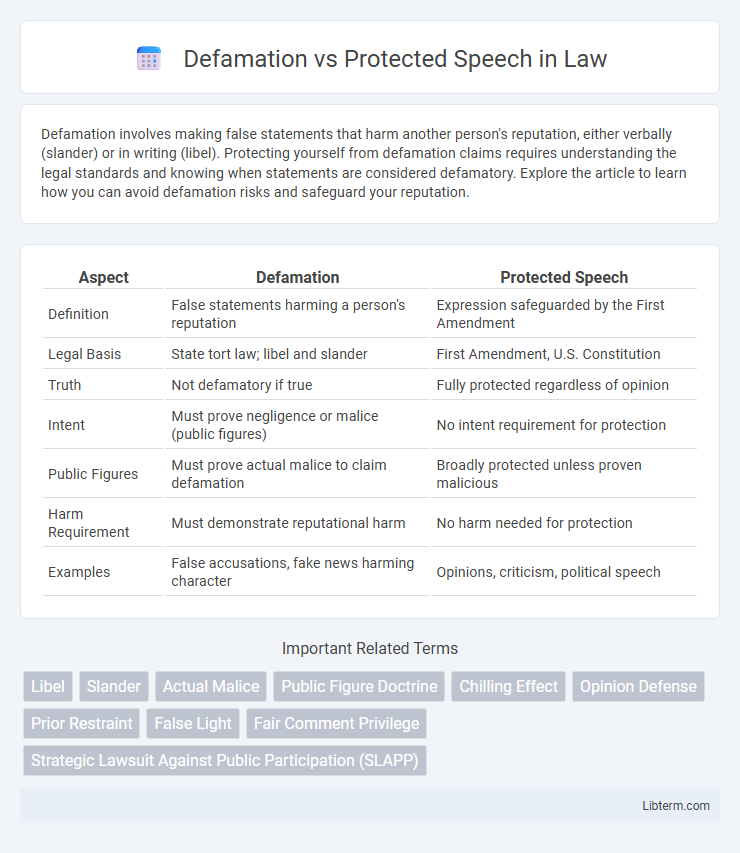Defamation involves making false statements that harm another person's reputation, either verbally (slander) or in writing (libel). Protecting yourself from defamation claims requires understanding the legal standards and knowing when statements are considered defamatory. Explore the article to learn how you can avoid defamation risks and safeguard your reputation.
Table of Comparison
| Aspect | Defamation | Protected Speech |
|---|---|---|
| Definition | False statements harming a person's reputation | Expression safeguarded by the First Amendment |
| Legal Basis | State tort law; libel and slander | First Amendment, U.S. Constitution |
| Truth | Not defamatory if true | Fully protected regardless of opinion |
| Intent | Must prove negligence or malice (public figures) | No intent requirement for protection |
| Public Figures | Must prove actual malice to claim defamation | Broadly protected unless proven malicious |
| Harm Requirement | Must demonstrate reputational harm | No harm needed for protection |
| Examples | False accusations, fake news harming character | Opinions, criticism, political speech |
Understanding Defamation: Definition and Key Elements
Defamation involves making false statements about an individual or entity that cause harm to their reputation, encompassing both libel (written) and slander (spoken). Key elements include a false statement presented as fact, publication or communication of the statement to a third party, fault amounting to negligence or intent, and demonstrable damage or harm to the subject's reputation. Understanding these components is essential in distinguishing defamation from protected speech under the First Amendment, which safeguards truthful, opinion-based, or privileged expressions.
Protected Speech: Scope and Limitations
Protected speech under the First Amendment safeguards expressions related to political opinions, artistic works, and public interest discussions, ensuring individuals can voice dissent without fear of legal reprisal. Limitations arise when speech involves incitement to violence, true threats, obscenity, or false statements made with actual malice that damage a person's reputation, which may be subject to defamation claims. The careful balance between protecting free expression and preventing harm defines the dynamic boundary where protected speech ends and defamation begins.
Legal Distinctions Between Defamation and Free Speech
Defamation involves false statements that harm a person's reputation, subject to legal liability if proven false and damaging. Protected speech under the First Amendment encompasses expressive communications that do not defame or incite illegal actions, safeguarding opinions and truthful statements. Courts balance the right to free speech against the harm caused by defamatory remarks by assessing falsity, intent, and public interest to determine legal boundaries.
The Role of Intent in Defamation Cases
The role of intent in defamation cases is crucial in distinguishing false harmful statements from protected speech under the First Amendment. Courts often require proof of actual malice, meaning the defendant either knew the statement was false or acted with reckless disregard for the truth, especially in cases involving public figures. This intent standard helps balance protecting individuals' reputations while upholding freedom of expression in public discourse.
Public Figures vs. Private Individuals: Different Standards
Public figures face a higher burden of proof in defamation cases, required to demonstrate actual malice--knowledge of falsity or reckless disregard for the truth--due to their influence and access to public platforms. Private individuals benefit from greater protection, as they only need to prove negligence to succeed in defamation claims, reflecting the law's intent to balance free speech and reputation. These differing standards underscore the judicial recognition of varying privacy expectations and the importance of protecting robust public discourse.
Burden of Proof in Defamation Lawsuits
In defamation lawsuits, the burden of proof primarily lies with the plaintiff, who must demonstrate that the defendant made a false and defamatory statement presented as a fact, causing harm to the plaintiff's reputation. Protected speech, especially under the First Amendment, shields expressions of opinion and truthful statements from defamation claims, requiring plaintiffs to prove actual malice when public figures are involved. Jurisdictions vary on standards, but the fundamental legal threshold ensures a balance between protecting reputations and preserving free speech rights.
Common Defenses Against Defamation Claims
Common defenses against defamation claims include truth, which serves as an absolute defense since proving the statement's accuracy negates falsity. Privilege, both absolute and qualified, protects certain communications made in specific contexts such as legislative proceedings or fair reporting on public matters. Another key defense is opinion, as statements framed clearly as personal beliefs or interpretations rather than factual assertions typically do not constitute defamation.
Impact of Defamation on Reputation and Society
Defamation undermines individual reputation by spreading false statements that can lead to loss of trust, social ostracism, and professional harm. Unlike protected speech, defamation imposes tangible damages on both personal lives and societal cohesion by fostering misinformation and fueling distrust. Legal systems balance free expression with accountability by penalizing defamatory acts to safeguard reputations and maintain public order.
Recent Landmark Cases: Defamation vs Protected Speech
Recent landmark cases such as Milkovich v. Lorain Journal Co. and Snyder v. Phelps have sharply defined the boundary between defamation and protected speech under the First Amendment. Courts emphasize that false statements presented as fact causing reputational harm constitute defamation, while opinions or controversial speech on public issues generally receive protection. These rulings clarify that speech critical of public officials or figures is shielded unless proven to be knowingly false or made with reckless disregard for the truth.
Best Practices for Balancing Expression and Responsibility
Defamation law requires careful navigation to protect reputations without stifling free speech, emphasizing truth and intent as key factors in legal defense. Best practices include verifying facts before publishing, clearly distinguishing opinion from false statements, and understanding jurisdictional variations in defamation statutes. Encouraging transparency and prompt corrections helps balance individual expression with accountability and legal responsibility.
Defamation Infographic

 libterm.com
libterm.com